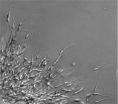(Press-News.org) A new finding in neuroscience for the first time points to a developmental mechanism linking the disease-causing mutation in an autism-related disorder, Timothy syndrome, and observed defects in brain wiring, according to a study led by scientist Ricardo Dolmetsch and published online yesterday in Nature Neuroscience. These findings may be at the heart of the mechanisms underlying intellectual disability and many other brain disorders.
The present study reveals that a mutation of the disease-causing gene throws a key process of neurodevelopment into reverse. That is, the mutation underlying Timothy syndrome causes shrinkage, rather than growth, of the wiring needed for the development of neural circuits that underlie cognition.
"In addition to the implications for autism, what's really exciting is that we now have a way to get at the core mechanisms tying genes and environmental influences to development and disease processes in the brain," said Dolmetsch, Senior Director of Molecular Networks at the Allen Institute for Brain Science.
"Imagine what we can learn if we do this hundreds and hundreds of times for many different human genetic variations in a large-scale, systematic way. That's what we are doing now at the Allen Institute," Dolmetsch continued.
In normal brain development, brain activity causes branches emanating from neural cells to stretch or expand. In cells with the mutation, these branched extensions, called dendrites, instead retract in response to neural activity, according to this study. This results in abnormal brain circuitry favoring connections with nearby neurons rather than farther-reaching connections. Further, the study identified a previously unknown mode of signaling to uncover the chemical pathway that causes the dendritic retraction.
This finding may have wide-reaching implications in neuroscience, as impaired dendrite formation is a common feature of many neurodevelopmental disorders. Further, the same gene has been implicated in other disorders including bipolar disorder and schizophrenia.
Under Dolmetsch's leadership, the Molecular Networks program at the Allen Institute, one of three major new initiatives announced by the Institute last March, is using similar methods on a grand scale. The Institute is probing a large number of human genetic variations and many pathways in the brain to untangle the cellular mechanisms of neurodevelopment and disease. In addition to identifying the molecular and environmental rules that shape how the brain is built, the program will create new research tools and data sets that it will share publicly with the global research community.
Timothy syndrome is a neurodevelopmental disorder associated with autism spectrum disorders and caused by a mutation in a single gene. In addition to autism, it is also characterized by cardiac arrhythmias, webbed fingers and toes, and hypoglycemia, and often leads to death in early childhood.
### The study was led by Ricardo Dolmetsch with colleagues at Stanford University.
Citation: Krey, JF et al. (2013) Timothy syndrome is associated with activity-dependent dendritic retraction in rodent and human neurons. Nature Neuroscience, advance online publication January 13, 2013.
About the Allen Institute for Brain Science
The Allen Institute for Brain Science (http://www.alleninstitute.org) is an independent nonprofit medical research organization dedicated to accelerating the understanding of how the human brain works in health and disease. Using a big science approach, the Allen Institute generates useful public resources used by researchers and organizations around the globe, drives technological and analytical advances, and discovers fundamental brain properties through integration of experiments, modeling and theory. Launched in 2003 with a seed contribution from founder and philanthropist Paul G. Allen, the Allen Institute is supported by a diversity of government, foundation and private funds to enable its projects. Given the Institute's achievements, Mr. Allen committed an additional $300 million in 2012 for the first four years of a ten-year plan to further propel and expand the Institute's scientific programs, bringing his total commitment to date to $500 million. The Allen Institute's data and tools are publicly available online at http://www.brain-map.org.
New discovery in autism-related disorder reveals key mechanism in brain development and disease
Findings published in Nature Neuroscience explain how Timothy syndrome mutation causes wiring defects associated with cognitive impairment
2013-01-14
ELSE PRESS RELEASES FROM THIS DATE:
Smoking, high blood pressure and cholesterol can be fatal for hemorrhage survivors
2013-01-14
"It is particularly important for subarachnoid haemorrhage survivors to refrain from smoking and to take care of their blood pressure and cholesterol levels; apart from age, these are the primary factors behind the increased risk of mortality," explains neurosurgeon Miikka Korja from the HUCH's Neurosurgery Department together with professor Jaakko Kaprio from the University of Helsinki's Hjelt Institute.
The most extensive population-based follow-up study ever carried out on the subject, jointly conducted by HUCH, the University of Helsinki, and the Finnish National ...
Depression after heart attack: Threat perception has to be addressed
2013-01-14
"Survivors of heart attacks are three times more likely to develop depression during the first six months after their heart attack, than people with no heart disease. If left untreated this contributes to a worse prognosis, for instance further cardiac events and possibly death. The causes for this high prevalence of depression after heart attacks are still unclear," said Prof. Claus Vögele, Professor of Clinical and Health Psychology at the University of Luxembourg and lead author of the publication entitled "Cardiac Threat Appraisal and Depression after First Myocardial ...
2 new studies show why biodiversity is important for pollination services in California almond
2013-01-14
Agricultural demand for pollination is growing more quickly than the supply of honey bees, the dominant species managed for crop pollination. Increasing the efficiency of pollination represents a way of increasing crop yield without any increase in agricultural intensity or area. A study recently published in the Proceedings of the Royal Society B: Biological Sciences (9 Jan 2013) 1, shows that the pollination effectiveness of honey bees in California almond orchards was greater in the presence of other bees.
Almond is a crop highly dependent on honey bee pollination ...
How does your garden glow?
2013-01-14
Nature's ability to create iridescent flowers has been recreated by mathematicians at The University of Nottingham. The team of researchers have collaborated with experimentalists at the University of Cambridge to create a mathematical model of a plant's petals to help us learn more about iridescence in flowering plants and the role it may play in attracting pollinators.
An iridescent surface appears to change colour as you alter the angle you view it from. It is found in the animal kingdom in insects, inside sea shells and in feathers, and is also seen in some plants. ...
How do happiness and sadness circuits contribute to bipolar disorder?
2013-01-14
Philadelphia, PA, January 14, 2013 – Bipolar disorder is a severe mood disorder characterized by unpredictable and dramatic mood swings between the highs of mania and lows of depression. These mood episodes occur among periods of 'normal mood', termed euthymia.
Prior research has clearly shown that brain emotion circuitry is dysregulated in individuals diagnosed with bipolar disorder. It is thought that these disturbances impair one's ability to control emotion and contribute to mood episodes.
Continuing this line of research, the January 15th issue of Biological Psychiatry ...
Global warming has increased monthly heat records by a factor of 5
2013-01-14
Monthly temperature extremes have become much more frequent, as measurements from around the world indicate. On average, there are now five times as many record-breaking hot months worldwide than could be expected without long-term global warming, shows a study now published in Climatic Change. In parts of Europe, Africa and southern Asia the number of monthly records has increased even by a factor of ten. 80 percent of observed monthly records would not have occurred without human influence on climate, concludes the authors-team of the Potsdam Institute for Climate Impact ...
Protein identified that can disrupt embryonic brain development and neuron migration
2013-01-14
Interneurons – nerve cells that function as 'dimmers' – play an important role in the brain. Their formation and migration to the cerebral cortex during the embryonic stage of development is crucial to normal brain functioning. Abnormal interneuron development and migration can eventually lead to a range of disorders and diseases, from epilepsy to Alzheimer's. New research by Dr. Eve Seuntjens and Dr. Veronique van den Berghe of the Department of Development and Regeneration (Danny Huylebroeck laboratory, Faculty of Medicine) at KU Leuven (University of Leuven) has identified ...
Research makes connetion between tubal ligation and increase in cervical cancer rates
2013-01-14
Women who have a tubal ligation – the surgical tying or severing of fallopian tubes to prohibit pregnancy – have less frequent Pap smears, which puts them at an increased risk for cervical cancer, according to research recently released by a team that included Cara A. Mathews, MD, a gynecologic oncologist at the Program in Women's Oncology at Women & Infants Hospital of Rhode Island.
The findings were part of the National Cancer Institute-funded study "Study to Understand Cervical Cancer Endpoints and Determinants" being conducted when Dr. Mathews was a fellow at the ...
Liver controls wasting in cancer
2013-01-14
Cachexia or wasting is a condition affecting up to 70 percent of cancer patients, depending on the type of cancer. It is characterized by a dramatic loss of body weight that is independent of food intake. Cachexia is seen particularly often and most pronounced in patients suffering from cancers of the digestive tract and the lungs. They may lose up to 80 percent of body fat and skeletal muscle. Muscle loss leads to weakness and immobility of patients and poorer response to treatment. An estimated 20 percent of cancer deaths are considered to be a direct consequence of cachexia, ...
Dynamic, dark energy in an accelerating universe
2013-01-14
This press release is available in Spanish.
It was cosmology that drew Irene Sendra from Valencia to the Basque Country. Cosmology alsogave her the chance to collaborate with one of the winners of the 2011 Nobel Prize for Physics on one of the darkest areas of the universe. And dark matter and dark energy, well-known precisely because so little is known about them, are in fact the object of the study bySendra, a researcher in the Department of Theoretical Physics and History of Science of the UPV/EHU's Faculty of Science and Technology.
"Observations tell us that ...
LAST 30 PRESS RELEASES:
Practical education: Clinical scenario-based program development
The impact of family dynamics on eating behaviour – how going home for Christmas can change how you eat
Tracing the quick synthesis of an industrially important catalyst
New software sheds light on cancer’s hidden genetic networks
UT Health San Antonio awarded $3 million in CPRIT grants to bolster cancer research and prevention efforts in South Texas
Third symposium spotlights global challenge of new contaminants in China’s fight against pollution
From straw to soil harmony: International team reveals how biochar supercharges carbon-smart farming
Myeloma: How AI is redrawing the map of cancer care
Manhattan E. Charurat, Ph.D., MHS invested as the Homer and Martha Gudelsky Distinguished Professor in Medicine at the University of Maryland School of Medicine
Insilico Medicine’s Pharma.AI Q4 Winter Launch Recap: Revolutionizing drug discovery with cutting-edge AI innovations, accelerating the path to pharmaceutical superintelligence
Nanoplastics have diet-dependent impacts on digestive system health
Brain neuron death occurs throughout life and increases with age, a natural human protein drug may halt neuron death in Alzheimer’s disease
SPIE and CLP announce the recipients of the 2025 Advanced Photonics Young Innovator Award
Lessons from the Caldor Fire’s Christmas Valley ‘Miracle’
Ant societies rose by trading individual protection for collective power
Research reveals how ancient viral DNA shapes early embryonic development
A molecular gatekeeper that controls protein synthesis
New ‘cloaking device’ concept to shield sensitive tech from magnetic fields
Researchers show impact of mountain building and climate change on alpine biodiversity
Study models the transition from Neanderthals to modern humans in Europe
University of Phoenix College of Doctoral Studies releases white paper on AI-driven skilling to reduce burnout and restore worker autonomy
AIs fail at the game of visual “telephone”
The levers for a sustainable food system
Potential changes in US homelessness by ending federal support for housing first programs
Vulnerability of large language models to prompt injection when providing medical advice
Researchers develop new system for high-energy-density, long-life, multi-electron transfer bromine-based flow batteries
Ending federal support for housing first programs could increase U.S. homelessness by 5% in one year, new JAMA study finds
New research uncovers molecular ‘safety switch’ shielding cancers from immune attack
Bacteria resisting viral infection can still sink carbon to ocean floor
Younger biological age may increase depression risk in older women during COVID-19
[Press-News.org] New discovery in autism-related disorder reveals key mechanism in brain development and diseaseFindings published in Nature Neuroscience explain how Timothy syndrome mutation causes wiring defects associated with cognitive impairment


